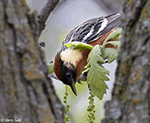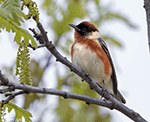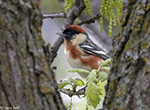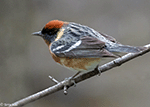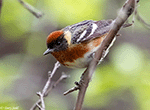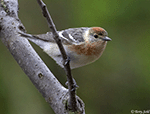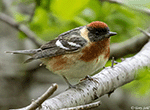| Length: 5.5 inches | Wingspan: 8.5 inches | Seasonality: All Seasons |
| ID Keys: Rusty sides and throat, chestnut crown, black face, buff patch on sides of neck, 2 white wing-bars. | ||
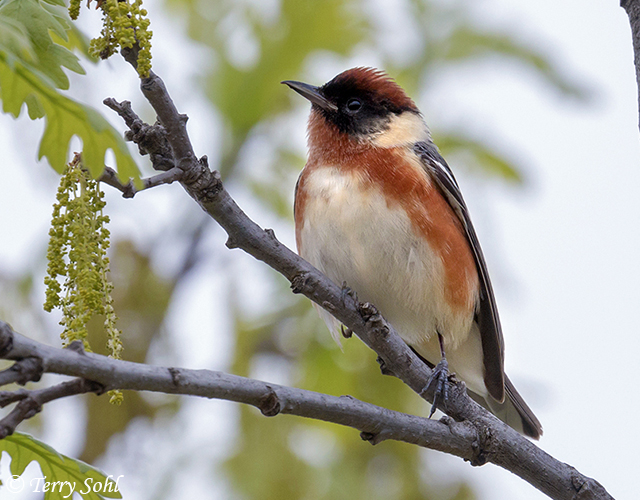 The
plumage of a male, breeding-plumaged Bay-breasted Warbler is rather unique for
North American Warbler species, as they forego the yellowish coloring seen on
many warlberes and instead have prominent, ruddy-chestnut coloring on their
flanks, throat, and crown. Despite the unusual appearance, they are
thought to be relatively close related to the Blackpoll Warbler, a species with
markedly different plumage and a lack of the coloring seen on Bay-breasted
Warblers. The two species have occasionally interbred, but hybrids have also
been noted between Bay-breasted Warblers and other warbler species.
Bay-breasted warblers summer in conifer forests of Canada and the northeastern
U.S. Populations of this warbler can vary dramatically, often rising
during outbreaks of conifer forest pests, especially spruce budworm. In
South Dakota, they are rare (spring) to uncommon (fall) migrants, being much
more common in the eastern part of the state.
The
plumage of a male, breeding-plumaged Bay-breasted Warbler is rather unique for
North American Warbler species, as they forego the yellowish coloring seen on
many warlberes and instead have prominent, ruddy-chestnut coloring on their
flanks, throat, and crown. Despite the unusual appearance, they are
thought to be relatively close related to the Blackpoll Warbler, a species with
markedly different plumage and a lack of the coloring seen on Bay-breasted
Warblers. The two species have occasionally interbred, but hybrids have also
been noted between Bay-breasted Warblers and other warbler species.
Bay-breasted warblers summer in conifer forests of Canada and the northeastern
U.S. Populations of this warbler can vary dramatically, often rising
during outbreaks of conifer forest pests, especially spruce budworm. In
South Dakota, they are rare (spring) to uncommon (fall) migrants, being much
more common in the eastern part of the state.
Habitat:
Bay-breasted Warblers can be found in a wide variety of forest/woodland habitats during migration. During the summer breeding season, they strongly prefer spruce or fir forest stands, but will use other types of tree as well.
Diet:
Primarily insects and spiders during the summer breeding season, but Bay-breasted Warblers will also eat fruits and berries, especially during the winter or cold snaps.
Behavior:
Primarily forages at mid-levels in spruce or other conifer stands, moving through branches in search of insects and primarily feeding in a gleaning fashion. May occasionally fly out to capture insects in flight while foraging.
Nesting:
Non-breeder in South Dakota. On their breeding grounds, the Bay-breasted Warbler builds a cup-shaped nest on the branch of conifer tree, from relatively close to the ground to 50 feet or higher in the canopy. The nest is constructed of twigs, conifer needles, lichen, and other vegetative material, with spider webs to help bind it together. It is also typically lined with finer material such as fine grasses, hair, mosses, and pine needles. The female lays four to six eggs, and she alone incubates them. Incubation lasts about 13 days, with young fledging from the nest in 11-14 days.
Interactive eBird Map:
Click to access an interactive eBird map of Bay-breasted Warbler sightings
Song:
The song of a Bay-breasted Warbler is a thin repetitive whistling note, wheezy-wheezy-wheezy.
1Click here to hear the song of a Bay-breasted Warbler, recorded in Quebec
2Click here to hear the call of a Bay-breasted Warbler, recorded in San Diego County, California
Migration:
Summers primarily in Canada, parts of the Northeastern U.S, and the northern Great Lakes region. Winters in Central and South America and parts of the Caribbean.
Similar Species:
A unique plumage with coloring not seen on many other warbler species, Bay-breasted Warblers could perhaps be confused with the following:
- Chestnut-sided Warbler. In breeding plumage, males share the same ruddy (chestnut) color on the side of the breast, but plumage differences are obvious elsewhere. The chestnut color is far more extensive on the Bay-breasted Warbler, covering more of the bird's flanks, and also the throat and crown. The throat of a Chestnut-sided Warbler are white, and they have an yellowish-green crown. The upperparts of a Chestnut-sided Warbler also has olive tones, while the Bay-breasted is streaked black, gray, and white. Female Chestnut-sided Warblers share the same yellowish-green tones on the back as the male (grayish on female Bay-breasted Warbler), have a yellowish-green crown (gray with some ruddy tones on a female Bay-breasted), and have relatively clean light gray underparts (some chestnut tones on the flanks of a female Bay-breasted Warbler).
Conservation Status:
There are some population fluctuations that follow availability of common prey insects, and trends from surveys in recent decades show a statistically noticeable decline in the overall population. However, they are still found over a wide geographic area and are relatively common in parts of their range. The IUCN considers the Bay-breasted Warbler to be a species of "Least Concern".
Further Information:
1) WhatBird - Bay-breasted Warbler
2) BirdWeb - Bay-breasted Warbler
3) Audubon Guide - Bay-breasted Warbler
Photo Information:
May 18th, 2019 - Good Earth State Park, South Dakota - Terry Sohl
Audio File Credits:
1Martin St-Michel, XC137479. Accessible at www.xeno-canto.org/137479
2Paul Marvin, XC147277. Accessible at www.xeno-canto.org/147277
| Click on the map below for a higher-resolution view |
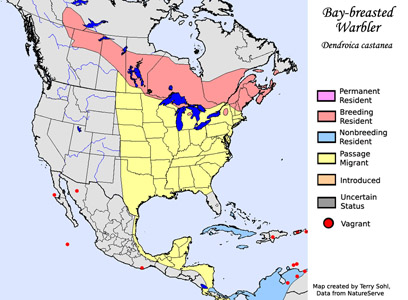 |
| South Dakota Status: Rare spring and uncommon fall migrant in the eastern part of the state. Accidental in the west. |
Additional Bay-breasted Warbler Photos
Click on the image chips to view the high-resolution versions
